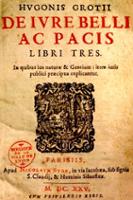The Unseen History of International Law: A Census Bibliography of Hugo Grotius’s De iure belli ac pacis
Thanks to the generous support of the Deutsche Forschungsgemeinschaft, we launched a five-year project to uncover an aspect of the history of international law by examining all surviving copies of the first ten editions of Hugo Grotius’s seminal On the Rights of War and Peace (De iure belli ac pacis, IBP). The ambition is to publish the resulting census bibliography in 2025, the 400th anniversary of IBP’s first publication.
IBP has been generally regarded as the inception of modern international law ever since its first edition in 1625. The first generation of readers valued IBP for its lucid systematisation of legal doctrine and irenic potential. In the middle of the Thirty Years’ War, one of the most traumatic conflicts in European history, IBP removed religion from international law, offering warring factions a common moral foundation and procedural standards and rules for negotiation. In terms of disciplinary genealogy and professionalisation, the first chair in public international law was established to expound IBP, and given to Samuel Pufendorf in Heidelberg. For centuries, commentaries, expositions and other forms of engagement with IBP dominated international law scholarship. A very large portion of what we now regard as primary sources in international law was originally written as secondary literature on IBP; and all major international law scholars had engaged with IBP since its first appearance in 1625. At key moments, including the demise of the Holy Roman Empire, the fall of Napoleon and the end of both world wars, multinational projects were devoted to restarting international law by reissuing IBP with new commentaries.
What if we could find and systematise all the annotations that thousands of statesmen, diplomats, and international law scholars have left in their copies over the last 400 years? Our project’s premise is that despite the enormous literature on IBP’s reception and influence, we cannot understand its impact without uncovering the history of IBP as a physical object, with thousands of unpublished annotations arguing or agreeing with the text, and updating and adapting its contents. Though a great deal has been written about the iconic role of IBP, what has never before been done is a census bibliography that locates and examines every surviving copy, and documents and analyses readers’ annotations, and the copies’ dissemination and movement over time throughout the world. When finished, the census will transform our understanding of the historical trajectories of international law.
You will find informations on how to help us in our pursuit of searching for IBP copies on our Website

Somos, Mark
BA, MPhil (Cantab.), LL.M (Sussex), AM, PhD (Harv.), PhD (Lugd.Bat.), FRHistS. DFG, Heisenberg Position


Jones Corredera, Edward
FRHistS, FRSA, PhD (Cantab), MA (Leiden), MA (Queen Mary, UoL), BSc (LSE), Senior Research Fellow


Dufour, Pablo
BA student of political science, University of Heidelberg and SciencesPo Paris
